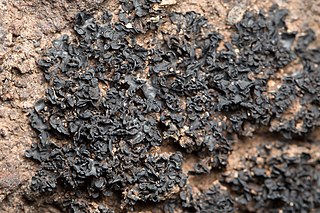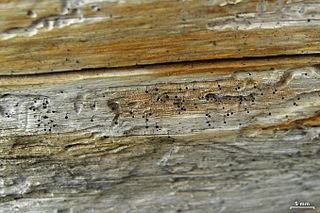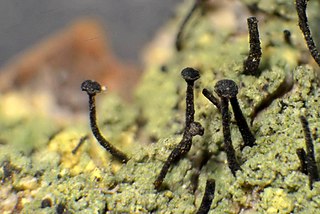Biatorellaceae is a family of lichen-forming fungi in the subclass Lecanoromycetidae. The family is monotypic, and contains the single genus Biatorella, which contains eight species.

The Lichinaceae are a family of ascomycete fungi. Most species are lichenized with cyanobacteria, and have a distribution largely in temperate regions.

The Graphidaceae are a family of lichen-forming fungi in the order Graphidales. The family contains nearly a hundred genera and more than 2000 species. Although the family has a cosmopolitan distribution, most Graphidaceae species occur in tropical regions, and typically grow on bark.

The Mycocaliciaceae are a family of seven genera and about 90 species of fungi in the order Mycocaliciales.
Sphaerophoropsis is a genus of lichenized fungi in the family Cladoniaceae. A monotypic genus, Sphaerophoropsis contains the single species Sphaerophoropsis stereocauloides. Both the genus and species were described as new to science in 1890 by Finnish lichenologist Edvard August Vainio, from collections made in Brazil.
Polyblastia is a genus of lichenized fungi in the family Verrucariaceae. As of 2020, it consists of about 40 species combined with about 50 orphaned species. The main difference with the genus Verrucaria is related to spores, which are muriform in Polyblastia.
Tylophoron is a genus of lichen-forming fungi in the family Arthoniaceae. The genus was circumscribed in 1862 by Finnish lichenologist William Nylander.

Candelariaceae is a family of lichen-forming fungi in the order Candelariales. It contains seven genera and about 73 species.

Chaenothecopsis is a genus of about 40 species of pin lichens in the family Mycocaliciaceae.

Mycocalicium is a genus of fungi in the family Mycocaliciaceae. The genus was circumscribed by Finnish lichenologist Edvard August Vainio in 1890.
Arthotheliopsis is a genus of fungi in the family Gomphillaceae. It has 5 species. The genus was circumscribed by Finnish lichenologist Edvard August Vainio in 1896, with A. hymenocarpoides assigned as the type species.
Tylophorella is a genus of lichen-forming fungi in the order Arthoniales. The genus has not been placed into a family. Tylophorella was circumscribed by Finnish lichenologist Edvard August Vainio in 1890, with Tylophorella polyspora assigned as the type species. T. pyrenocarpoides was added to the genus in 1993.

The Caliciaceae are a family of mostly lichen-forming fungi belonging to the class Lecanoromycetes in the division Ascomycota. Although the family has had its classification changed several times throughout its taxonomic history, the use of modern molecular phylogenetic methods have helped to establish its current placement in the order Caliciales. Caliciaceae contains 39 genera and about 670 species. The largest genus is Buellia, with around 300 species; there are more than a dozen genera that contain only a single species.

Bunodophoron is a genus of lichen-forming fungi in the family Sphaerophoraceae. The genus has a broad distribution in the Southern Hemisphere, with several species also present in oceanic regions of the Northern Hemisphere.

Allocalicium is a single-species fungal genus in the family Caliciaceae. It is monotypic, containing the single pin lichen species Allocalicium adaequatum. This lichen occurs in North America, South America, Europe, and the Russian Far East, where it grows on branches and twigs of deciduous trees and shrubs, typically those of alder and poplar. The species was originally described in 1869 as a member of Calicium, but molecular phylogenetics analysis demonstrated it was not a member of that genus and so Allocalicium was created to contain it.

Opegraphaceae is a family of lichen-forming and lichenicolous fungi in the order Arthoniales. It was originally proposed by German lichenologist Ernst Stizenberger in 1862. It fell into disuse, but was resurrected in a molecular phylogenetic study of the order Arthoniales published in 2010. It now includes taxa that were previously referred to the family Roccellaceae, its sister group.

Carbonicola is a small genus of lichen-forming fungi. It is the sole genus in the monogeneric family Carbonicolaceae. The genus, which collectively has an almost cosmopolitan distribution, contains three squamulose lichens that prefer to grow on burned wood in temperate areas of the world.

Thelenellaceae is a family of lichen-forming fungi. It is the sole family in the monotypic order Thelenellales, and contains three genera and about 50 species.
Moriola is a poorly-known genus of fungi in the family Verrucariaceae. It has 17 species. Members of the genus parasitise various algal species; some species are considered to be saprotrophic or "doubtfully lichenized".
Strangospora is a genus of lichen-forming fungi. It is the only genus in the family Strangosporaceae, which itself is of uncertain taxonomic placement in the Ascomycota. It contains 10 species.












